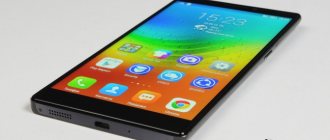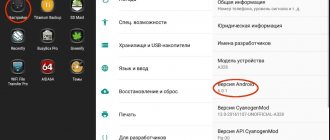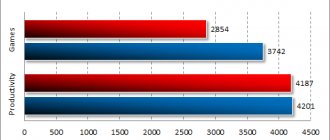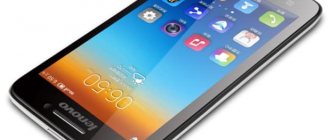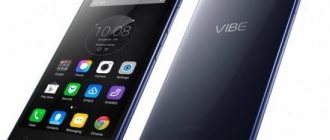Working hours
Lenovo Vibe X3 is equipped with a non-removable lithium-polymer battery with a capacity of 3500 mAh. According to subjective feelings, the smartphone “lives” for quite a long time - it can easily last for a day with intensive use, and in medium load mode it can just as easily last two days. In the corresponding PCMark benchmark, it showed a very impressive result of almost 9 hours (for comparison, the LG G3 with a 3000 mAh battery that was on hand lasted only 5 hours).
Display
Lenovo Vibe X3 uses a 5.5-inch diagonal IPS screen with Full HD resolution (1920X1080 pixels). The pixel density is 401 PPI, which is more than enough so that even the most “big-eyed” user cannot distinguish individual pixels, no matter how closely he looks.
Measurements showed that the minimum brightness of this smartphone is 5 cd/m², the maximum is as much as 457 cd/m². This is a very high indicator; with such brightness, the image on the screen can be viewed without any problems even outdoors in sunny weather. But if this doesn’t seem enough, in the settings (screen – color balance) you can turn on the high brightness mode, in which this figure rises to 557 cd/m². The color temperature is somewhat high, this makes the image a little cold - if this bothers you, the user can manually adjust the color balance in the above-mentioned menu using a special slider, or simply select “adaptive mode”, in which the image becomes frankly warm and more pleasant for long reading from the screen.
The Lenovo Vibe X3 screen demonstrates very bright and saturated colors, which you usually expect to see in AMOLED devices - however, it uses an IPS matrix, albeit with a very large color gamut (you can see this by setting the brightness to maximum and looking at a black area of the image at a high angle - it will turn dark purple, which is typical for this technology). Also worth noting are the deep blacks, high contrast (1030:1) and wide viewing angles, at which the brightness decreases very slightly.
Hardware platform and performance
The Lenovo Vibe X3 uses a fairly powerful system-on-chip - a 64-bit six-core Qualcomm Snapdragon 808, with two powerful ARM Cortex-A57 cores operating at frequencies up to 1.82 GHz, and four more economical ARM Cortex-A53 with frequencies up to 1.44 GHz . The Adreno 418 graphics processor is responsible for video processing. The smartphone has 3 GB of RAM, 32 GB of internal memory (24.3 GB available to the user), which can be further expanded using a microSD card.
In terms of performance, the Snapdragon 808 is now at the “medium-high” level, and does not suffer from overheating, like the 810 model announced at the same time - it is not surprising, therefore, that it has become a very popular chip and is used in a number of high-end devices. In benchmarks, Lenovo Vibe X3 confidently occupies the top lines in the rating tables, and even in modern heavy games it allows you to enjoy a smooth picture without slowdowns or lags. At the same time, it does not heat up much, and in everyday use it is barely warm at all.
Camera
The main camera boasts a 21-megapixel sensor made by Sony with a phase detection autofocus system. In sufficient lighting conditions, it focuses almost instantly and allows you to take high-quality images, with excellent detail, natural colors and a fairly good dynamic range. At dusk or when shooting in dimly lit rooms, detail is expected to decrease, but the pictures are still very high quality. Automatic white balance works quite correctly for the most part, “misses” happen infrequently and are relatively small.
The camera application turns out to be very functional: it allows you to change the proportions and size of the photo, adjust the white balance, select sensitivity and shooting method (normal/touch/timer/smile), switch between average and center-weighted exposure metering, display auxiliary lines and level (with with the help of which you can finally get rid of comments in the spirit of “the horizon is littered”). In addition, you can turn off the shutter sound, assign zoom to the volume buttons, enable flicker reduction, and for video shooting, select the video frame resolution, from 480p to 4K.
In addition to the main automatic mode (in which you can enable the Smart function, which selects the most optimal shooting option), the Lenovo Vibe X3 camera has several additional ones - panorama shooting (regular and selfie), several night mode options, background blur, fast / slow shooting and HDR . However, by the latter the manufacturer clearly means something of its own - none of the proposed HDR options offers a truly extended dynamic range, creating images with more or less over-saturation (up to completely unnatural-looking colors, more suitable for advertising postcards).
Calls, multimedia
Lenovo Vibe X3 supports the installation of two nano-SIM SIM cards (a microSD memory card can be used instead of one of them). The speaker is very loud, the voice of the interlocutor sounds clear and natural, you can understand it without any problems even in a rather noisy environment.
The smartphone is equipped with stereo speakers with a power of 1.5 W each, their volume is also high, mid and high frequencies are worked out quite well for this size, but the sound lacks depth and in certain situations a barely audible rattling may appear. The stereo effect when listening to music is felt weakly (the distance between the speakers is too small), but when watching a movie it turns out to be much more noticeable. The manufacturer reports that the speakers are “equipped with Dolby Atmos technology” - in fact, this means the presence of an application of the same name designed to improve sound quality. Unlike other Lenovo models, in the Vibe X3 it is not implemented as a separate program, but is available in the system settings. After activating this mode, you can select one of the predefined templates (movies/music/games/voice) or create your own profile. Each of the options can be further customized - turn on/off auto volume, speech correction and virtual surround sound, as well as adjust the graphic equalizer parameters. We would not recommend turning on this technology on built-in speakers when listening to music (if it suddenly occurs to someone) - there is a difference, although small, but we cannot say that it improves the sound. But when watching movies, the situation turns out to be completely different - turning on Dolby Atmos radically improves the sound, giving it volume and depth.
To reproduce sound, the smartphone uses a powerful ESS ES9018K2M DAC, which, according to its manufacturer, was created specifically for “audiophile” devices, including smartphones. It is worth noting that the Lenovo Vibe X3 plays really well with high-quality headphones - the sound is clear, rich, with deep bass and soft, but nevertheless detailed high frequencies. For those who like something “brighter”, we recommend turning on the “Turbo Hi-Fi” option in the settings, and if that’s not enough, activate Dolby Atmos and play around with the music mode settings.
Conclusion
Lenovo presented several very good smartphones this year, I would even say they presented them unexpectedly. If you had asked me at the beginning of the year which vendor I was expecting not one, not two, but several good models, I would have named anyone, but not Lenovo. I never liked their smartphones, what’s there to hide. They were gray bricks with incomprehensible software, sorry. But this year Lenovo did it. I liked at least three smartphones and at least two – very much! Vibe X3 is one of them. For $500 you get virtually the flagship model for this year, with a good display, camera, performance, practical body and the best audio hardware on the market, paired with the Meizu Pro 5. This smartphone deservedly earned its place in our top devices for 2015 and we can recommend it for purchase.
Design
Lenovo Vibe X3 came in a white case. There is aluminum edging on the sides and a matte plastic panel on the back. On the front, the inner frame merges with the screen when turned off, but when turned on it is clearly visible. There are three buttons at the bottom.
The front side is covered with a protective coating Gorilla Glass 3, which practically does not leave fingerprints. There are stereo speakers on a white background, and an activity indicator and selfie camera on a black background. Along the perimeter you can see where SIM cards, headphones and a micro USB cable are inserted. It is not difficult to notice the power key, volume control and infrared port. At the back, under the camera, there is a flash and a fingerprint scanner.
For ease of screen control, Lenovo has implemented a micro-screen function that creates a smaller active display with dimensions of 3.2-4 inches to make the smartphone more comfortable to use with one hand.
Equipment
The smartphone comes in a stylish medium-sized box made of white cardboard with turquoise inserts. Inside you can find a charger, a headset, a USB cable, a user manual and a paper clip for removing the SIM card tray.
Operating system and shell
Lenovo Vibe X3 uses Android 5.1.1, supplemented by a new version of the proprietary Vibe UI shell. In it, the manufacturer has carried out significant “work on bugs” - the first thing that catches your eye is the application menu that has appeared, which was previously absent in this shell (following the example of MIUI or iOS). The visual style, however, remains as bright and still resembles the above-mentioned systems - both in the appearance of system icons and in the organization of folders.
Among the interesting features, it is worth noting the flexible configuration of the notification panel (the user can select the number of columns, the switches displayed in it and the order in which they appear, enable the display of the current download speed from the Internet, adjust the display of notifications by various applications, etc.). We also note the function of increasing the ringer volume when the smartphone is in the pocket, the “safe zone” (a kind of “sandbox” with its own set of applications), called up using the “floating” smart menu button with quick access to various options, the “smart scenarios”, which allows you to create special “behavior templates” according to a schedule or by reference to specific Wi-Fi networks.
Vibe UI supports interchangeable interface themes (with its own weather widgets, wallpapers, application icons, etc.) and various styles of the lock screen, and also allows you to switch between two types of task manager - the “voluminous card index” of Android L and Lenovo’s own version.
The smartphone is equipped with a fingerprint scanner - it is located on the back side, under the flash, so that it is convenient to touch it with your index finger. Fingerprint recognition is reliable, without glitches (to prevent the system from recognizing you, you need to place your finger completely “edge-on”; the angle does not matter - the smartphone can be unlocked even if you hold it upside down). The recognition speed is quite high, according to subjective feelings – less than half a second.
There are many pre-installed applications - Route 66 “Navigate” navigator, Guvera music service client, UC Browser browser, e-book and audiobook reader, official Twitter, Facebook and Skype clients, pedometer, Evernote note editor, GameStore game store, ubiquitous McAffee Mobile Security antivirus, universal Peel remote control, SHAREit file transfer application, SYNCit local contacts backup utility, UC Browser, WPS Office, etc., and not all of them can be completely removed - some applications can only be disabled and installed updates for them.
